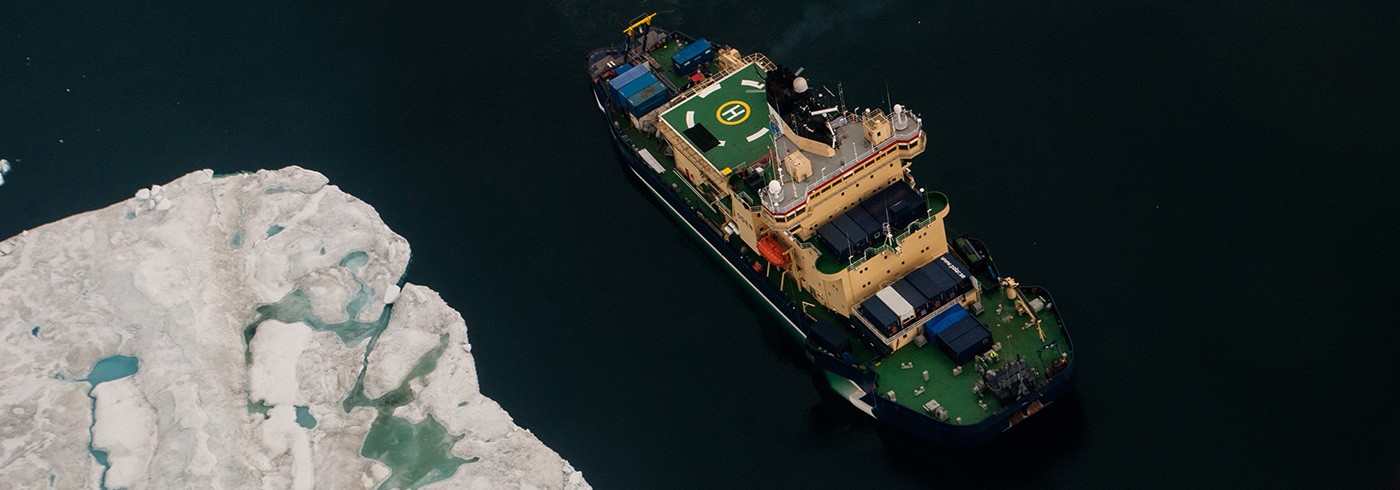The icebreaker Oden will depart from Longyearbyen, Svalbard, 8 August to meet up with the Canadian icebreaker Louis S. St-Laurent and launch the expedition. For six weeks, the vessels will operate in the Arctic Ocean, mainly in the Amundsen Basin and in areas around the underwater mountain ranges Lomonosov Ridge and Alpha Ridge.
Lead Scientist, Louis S. St-Laurent
Mary-Lynn Dickson
Natural Resources Canada
Co-Lead Scientist, Oden
Katarina Gårdfeldt
Chalmers University of Technology
Liaison Officer, Oden
Gary Sonnichsen
Natural Resources Canada
Åsa Lindgren
Swedish Polar Research Secretariat
Collecting seafloor data
The aim of the Canadian research programme is to collect data in support of Canada’s extended continental shelf submission to the Commission on the Limits of the Continental Shelf, prepared in accordance with the United Nations Convention on the Law of the Sea (UNCLOS).
Researchers on board the two vessels will map the seafloor’s appearance and structure. Seismic reflection and refraction data will be collected using a streamer and hydrophones, as well as sonobuoys deployed on the sea ice. Rock samples will be collected using dredging equipment. Geophysical mapping of the seafloor and water column imaging will be carried out using multibeam echo sounder and sub-bottom profiler. The researchers will also collect sediment cores using a piston corer.
Environmental chemistry, marine geology and atmospheric research
The Swedish research is focused on environmental chemistry, marine geology and atmospheric research. On board Oden there will also be Danish and Norwegian researchers working with marine geology and ice management.
Heavy metals in air, sea, snow and ice
The environmental chemistry project investigates deposition and re-emission patterns of heavy metals, especially mercury, in air, sea, snow and ice. One aim is to study the role of sea ice in the transport of pollutants. It is generally believed that sea ice in the polar regions acts as a cap for dissolved gaseous mercury (DGM) in sea water and prohibits mercury evasion from the ocean surfaces to the atmosphere. Therefore, it is of interest to measure the concentration of mercury and other contaminants in both ice-free and ice-covered areas. This kind of data is important in order to estimate the accumulation of pollutants in a changing Arctic.
Researchers will make air measurements and collect samples from ice cores, snow and seawater. Water samples will be collected with the help of a CTD sampler, to get data on conductivity, temperature and depth. Data from the CTD measurements will also support other research projects.
Principal investigator
Katarina Gårdfeldt
Chalmers University of Technology
Geophysical mapping
In the marine geology project, researchers are using multibeam echo sounder and sub-bottom profiler to map the seafloor’s appearance and structure. Based on collected data, it is possible to find suitable areas for sediment coring. The sediment cores acts as an archive that may provide clues about the Arctic Ocean’s geological and oceanographic development.
Principal investigator
Martin Jakobsson
Stockholm University
Boundary-layer meteorology
The atmospheric research will investigate the energy exchange in the boundary-layer, i.e. the layer of the atmosphere closest to the earth’s surface. With the help of continuous measurements, the researchers will collect data on the exchange of heat energy, water and momentum between the atmosphere and ocean. The researchers will also measure the fluxes of aerosols and greenhouse gases and examine the impact of low clouds on the energy balance at the surface.
Analysis of the collected data will contribute to a better understanding of important climate processes in the Arctic, which is a cornerstone for developing better models of weather and climate.
Principal investigator
Michael Tjernström
Stockholm University
Trace gas biogeochemistry
Researchers will do continous, high-resolution measurements of the greenhouse gases methane and carbon dioxide. Measurements in the boundary layer of these two gases are of great interest in the high Arctic, where measurements are sparse. The monitoring systems on Oden add greatly to multiyear datasets in Arctic seas. Such datasets are needed to understand how the air-sea exchange of these gases in the Arctic are changing, and may change, in the future due to Arctic warming.
Principal investigator
Patrick Crill
Department of Geological Sciences, Stockholm University
Sea ice measurements
This project is using an ice radar to make continuous measurements of sea ice thickness from the icebreaker Oden. Different antenna types and different frequency ranges will be tested and the software will be adapted for use on a ship. The radar system has previously been used for snow and ice measurements in Antarctica and in Swedish fells.
Principal investigator
Per Holmlund
Stockholm University
Early career scientists
The Swedish Polar Research Secretariat has invited nine early career scientists to participate on board the icebreaker Oden. They will work in different research areas, with a senior researcher as mentor, and thus get a comprehensive education in marine field methods. Two researchers will work with extended research projects; one project studying microplastics in the ocean and one project studying aerosols.
An artist will participate in the expedition
The director Åsa Johannisson, Stockholm University of the Arts, and artistic director of Circus Glass Royale, will participate in the expedition as part of the Swedish Polar Research Secretariat’s artists programme. The aim of her project is to investigate and critically reflect on interdisciplinary collaboration between art and research. Among other things, the project will be presented as Polar on stage, a performance with music, theatre and visual arts, in collaboration with Share Music Sweden, Grenna Museum, the Svalbard Museum, Iceland Academy of the Arts and the University of Gothenburg.
In Swedish

